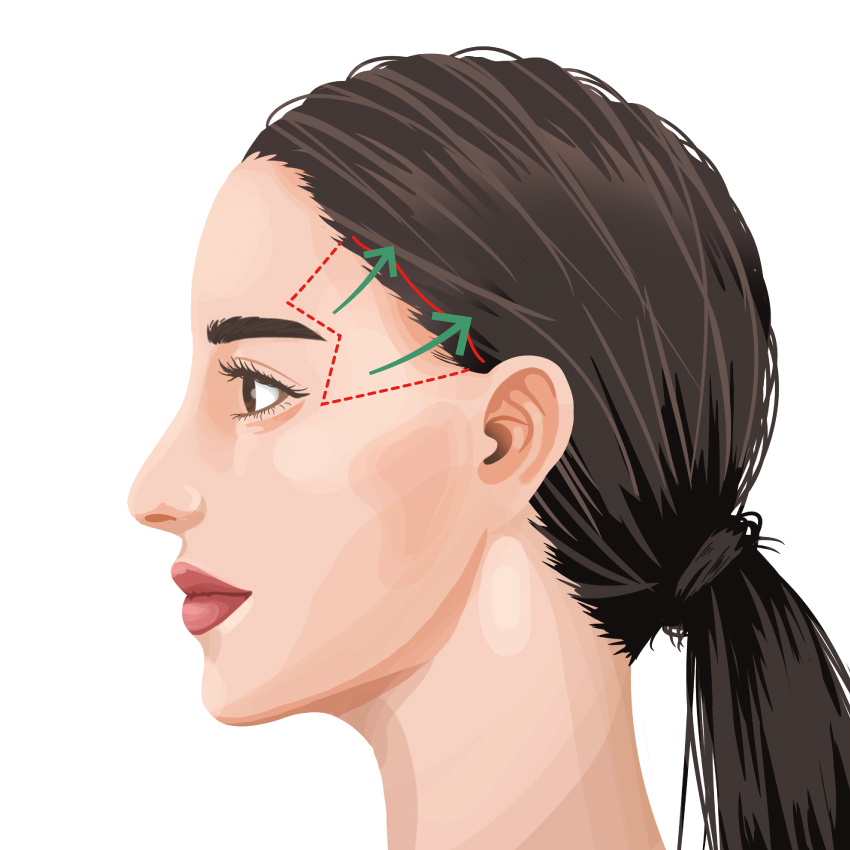
Temple Lift

Rejuvenate and brighten the eye area by drooping around the temples and lifting sagging
Point.1 : Lift sagging skin on the outer corners of the eyes, brow tails, and upper eyelids
Point.2 : Since the incision is made near the hairline, scars are inconspicuous and the finish is natural
Point.3 : Also expected to lift sagging and puffiness in the midface
Interpretation and counseling services are free of charge.
*Some doctors may require an additional fee for selection.
Price List
Treatment Area
-
Temples
Temple Lift
Rejuvenate and brighten the eye area by drooping around the temples and lifting sagging
Point.1 : Lift sagging skin on the outer corners of the eyes, brow tails, and upper eyelids
Point.2 : Since the incision is made near the hairline, scars are inconspicuous and the finish is natural
Point.3 : Also expected to lift sagging and puffiness in the midface
Interpretation and counseling services are free of charge.
*Some doctors may require an additional fee for selection.
Recommended for
-

Are concerned about wrinkles and sagging around the eyes
-

Want to correct drooping eyebrows
-

Want to lift sagging at the outer corners of the eyes due to aging
-

Want firmer lower eyelids
-

Want to tighten their midface
-

Prefer procedures with less visible scarring
RESULTS
Coming Soon
FEATURES
-
What is a Temple Lift?
A temple lift is a plastic surgery procedure that rejuvenates the eye area by making an incision near the temples (temple region) to remove sagging skin and lift it upward. With age, the amount of collagen and elastin—components that support the skin—decreases, reducing skin elasticity and causing sagging. This also affects the eye area, leading to the drooping of the brow and outer corners of the eyes, which can create a heavy look.
By lifting these drooping parts, the temple lift corrects the lines of the eyelids and eyebrows, resulting in a refreshed, brighter eye area. It is especially effective for concerns such as sagging upper eyelids, drooping brows, and fine wrinkles around the outer corners of the eyes. It is a popular option for those seeking a naturally youthful eye appearance. -
Targeting Areas Where Scars Are Hard to Notice
In a temple lift, incisions are made inside the hair or along the hairline —areas naturally hidden by hair. This minimizes the visibility of post-operative scars. Since hairline shape, hair volume, and growth direction vary by individual, we carefully select the most inconspicuous incision location for each patient. Moreover, the incision and suturing lines are made in a zigzag shape rather than straight, further minimizing scar visibility.
The templel lift incision length is typically small—around 4–6 cm. Sutures are generally removed approximately one week after surgery. Because the incision area is discreet, the procedure is less likely to be noticed by others, making it suitable even for those with active daily lives. -
Not Only for the Eyes – Ideal for Nasolabial Folds and Tear Trough Lines
The templel lift not only addresses sagging around the eyes but also improves midface aging signs such as nasolabial folds and tear trough lines (also called “gorge lines”). These aging signs are mainly caused by weakening of facial and orbicularis muscles, and reduction in subcutaneous collagen, elastin, and hyaluronic acid as we age. Such changes contribute to an aged facial appearance.
By lifting the skin and tissues diagonally upward from the temples to the cheeks, the temple lift raises the position of the cheeks and creates a youthful contour. The procedure may also reduce cheek volume, leading to a slimmer-looking midface. It is chosen not only for current sagging but also as a preventive measure against future sagging—a proactive investment in long-term beauty.
-

Downtime after Temple Lift
After surgery, you may experience pain, swelling, or bruising. Although individual responses vary, noticeable swelling usually subsides within a week, and bruising fades within approximately 10 days.
Treatment Benefits
-
Long-lasting Effects
By securely fixing the fascia and skin, the results are expected to last for an extended period.
-
Makeup Allowed from the Day After Suture Removal
Makeup is permitted starting the day after suture removal, which is typically about one week post-surgery. Any remaining swelling or bruising can be hidden with foundation or concealer.
-
Anxiety about Pain is Minimized with Anesthesia
The procedure is generally performed under local anesthesia. Depending on your preference, we also offer options such as sedation or intravenous anesthesia.
TREATMENT PROCESS
-
Doctor Consultation and Counseling
The doctor will examine your facial condition to determine if a templel lift is appropriate, while listening carefully to your concerns and desired outcomes. We will also explain the procedure flow, post-operative care, and precautions in detail. Please feel free to ask any questions or express any concerns.
The doctor will examine your facial condition to determine if a templel lift is appropriate, while listening carefully to your concerns and desired outcomes. We will also explain the procedure flow, post-operative care, and precautions in detail. Please feel free to ask any questions or express any concerns.
-
Marking the Treatment Area
Based on your bone structure, skin condition, and facial volume, we simulate the outcome and mark the surgical area accordingly.
Based on your bone structure, skin condition, and facial volume, we simulate the outcome and mark the surgical area accordingly.
-
Anesthesia
Prior to the procedure, anesthesia is administered. Once its effect is confirmed, the treatment begins.
Prior to the procedure, anesthesia is administered. Once its effect is confirmed, the treatment begins.
-
Procedure
An incision of a few centimeters is made inside the hair or along the hairline of the temple region. The skin and tissues are firmly lifted diagonally upward. If necessary, excess skin and fascia are removed before suturing. The procedure takes approximately 180 minutes. If there are no complications, you may return home the same day.
An incision of a few centimeters is made inside the hair or along the hairline of the temple region. The skin and tissues are firmly lifted diagonally upward. If necessary, excess skin and fascia are removed before suturing. The procedure takes approximately 180 minutes. If there are no complications, you may return home the same day.
-
Suture Removal
Please return to the clinic one week after surgery for suture removal. You may begin wearing makeup starting the following day.
Please return to the clinic one week after surgery for suture removal. You may begin wearing makeup starting the following day.
PRICE LIST
View the price list for Temple Lift
| Regular | ¥550,000(tax inc.) |
FAQ
- Q When can I start wearing makeup after a temple lift?
-
A
You may begin wearing makeup starting the day after suture removal.
- Q Will I feel pain during the surgery?
-
A
We perform the procedure with great attention to minimizing pain. It is done under anesthesia—typically local anesthesia, but sedation or intravenous anesthesia is also available upon request. If combined with other procedures such as a facelift (a type of plastic surgery), general anesthesia may be used. Pain relievers and antibiotics are prescribed postoperatively, and suppositories can be provided if necessary.
- Q When are the sutures removed?
-
A
Sutures are usually removed about one week after the procedure.
- Q When can I resume exercise after the surgery?
-
A
Refrain from vigorous exercise or activities that promote circulation, such as saunas, for about one week, as they can increase pain and swelling.
- Q How long is the downtime after a temple lift?
-
A
Although it varies by individual, downtime typically lasts 1–2 weeks. Post-operative symptoms such as pain, swelling, and bruising are temporary and will subside with time. If symptoms persist, please contact our clinic for a follow-up consultation.
- Q Can a temple lift correct downturned eyes?
-
A
Yes, a temple lift can lift sagging at the outer corners of the eyes and surrounding areas, and is considered effective for correcting downturned eyes caused by drooping in the temples or eye corners. Feel free to consult with us.
- Q How long does the feeling of tightness last after the procedure?
-
A
Some patients feel tightness due to the skin being lifted around the temples. This usually subsides gradually over about one month, or up to three months in longer cases.
- Q How long do the effects of a temple lift last?
-
A
Results vary per individual but typically last several years, and in some cases, up to 10 years. Because the fascia and skin are securely fixed, long-lasting effects are expected.
- Q Are there any recommended procedures to combine with a temple lift?
-
A
The temple lift also targets midface sagging, but for those with significant cheek sagging or seeking more dramatic results, combining it with a plastic surgery facelift is recommended. This allows for a broader range of lifting and can lead to greater overall satisfaction.



